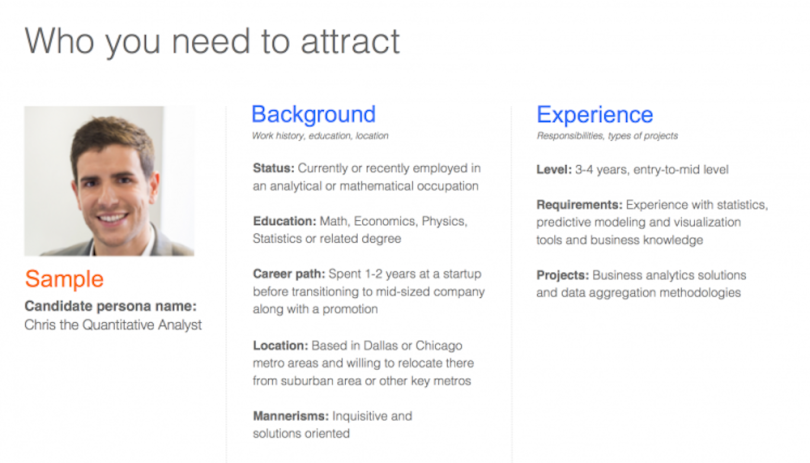Do you believe in fate? How about finding the perfect candidate at first sight?
Finding the right candidate takes a lot more than posting a job description and waiting for someone to apply... unless you're willing to wait weeks or months for the ideal candidate to land in your inbox, that is.
Instead of focusing your candidate search around gut feelings and assumptions, optimize your time, money and recruiting efforts around targeting the ideal candidate based on facts and research with a candidate persona.
Learn the what, why and how of creating a candidate persona with a few examples in this guide.
Table of Contents
- What Is A Candidate Persona?
- Why Are Candidate Personas Important?
- How To Create A Candidate Persona
- Examples Of Candidate Personas
- Candidate Persona Template
What Is A Candidate Persona?

A candidate persona is a fictional profile of an ideal candidate for a specific role that is both detailed and data driven.
Creating a candidate persona involves a process of thorough research and first-hand interviews to determine the most important characteristics a candidate must possess in order to be successful in the role and become an asset to their team.
Characteristics that help define a candidate persona include:
- Work experience
- Education (degrees and certificates)
- Geographical location
- Specific skill sets
- Communication style
- Preferred work environment
- Professional goals and motivators
- Personal online presence
This may seem like a lot of information to gather and organize — and you’re right, it is. However, putting in the effort up front will drastically help your recruitment efforts in the long run, and here’s why...
See how your employer brand is performing in AI tools like ChatGPT and Google.
Why Are Candidate Personas Important?
Creating candidate personas for each open role helps companies understand exactly what they’re looking for in a candidate before the recruitment process begins. These are a few key areas that benefit from creating specific candidate personas.
Tailor Job Descriptions
The job description is one of the first touch points a candidate has with your company, which is why it is crucial to write job descriptions that reflect your specific candidate persona.
Doing so will help candidates better understand what a company is looking for in a candidate, allowing them to determine whether or not they see themselves as a match for the role before applying.
This will, in turn, ensure that more qualified candidates apply for a role, saving you time reviewing fewer unqualified applications.
Not sure where to start with your job descriptions? Check out our templates.

Optimize Sourcing & Recruitment Marketing
If you know who, then you should know where. Understanding who you are targeting will give you better insight into where you can source them.
For example, if you’re looking for a remote senior Android Engineer, you may post your job description on Android Jobs to reach a more targeted audience. But if you’re looking for a Social Media Strategist, you’re more likely to find them with targeted ads on Facebook.
Additionally, your recruitment marketing strategy will benefit from candidate personas because your team will be able to better predict what kind of content will resonate with specific prospective candidates.
Integrate Diversity Initiatives
A great way to implement diversity hiring initiatives is by identifying gaps at your company and building candidate personas that help you actively target candidates that will bring fresh ideas, experiences and personalities to your team.
This will help your team in their efforts to build a more diverse and inclusive work environment, and in return, your team will be more engaged with their work, as well as more productive and innovative.

Improve Recruitment Metrics
The candidate persona will follow you throughout your recruitment process, and if done well, you will reap the benefits in time, money and resources. Nearly every significant recruitment metric will benefit from taking the time to create thorough candidate personas.
- Application Completion Rate. Your candidate person will help determine the best platform and process to optimize application completion rate. For example, if you're targeting commuters or millennials, make sure your application is brief and mobile friendly.
- Time To Hire. Once you’ve really nailed the candidate persona and you know exactly who and where the right candidates are, time to hire will decrease drastically because you won’t be wasting time on candidates or platforms that aren’t quite right.
- Cost Per Hire. Many factors contribute to your cost per hire, so when other aspects of your recruitment process are sped up and optimized, naturally, your cost per hire will also improve.
- Offer Acceptance Rate. Because you have established a clear outline of the ideal candidate, and that information is reflected in your job description and recruitment marketing materials, when the right candidate comes along, neither you nor the candidate will even consider rejecting an offer.
- Quality Of Hire. Candidates don’t want to waste time applying for a job they’re not actually interested in just as much as you don’t want to waste time reviewing the applications of unqualified or uninterested candidates. Candidate personas will ensure that every aspect of your recruitment process clearly communicates what you’re looking for, thus yielding top candidates right for the role.
- Employee Retention Rate. An elevated quality of hire will lead to an elevated retention rate. Candidates know what to expect from their role because you’ve made that clear throughout the recruitment process and therefore are more likely to stay at the company longer.
How To Create A Candidate Persona
By now you understand the importance of creating a candidate persona and what that means. Now we’re going to walk you through how to create a candidate persona.
After this, we’ll look a few examples and finish with a template for you to utilize and adapt for your own recruiting purposes.

1. Research The Role
While you may think you know what to look for in a candidate, have you ever sat down and done some research to determine what exactly it is your team needs in the next hire to boost performance?
There are several components of research you should consider as you build a candidate persona. You’ll want to answer a few key questions, such as: Where will they come from? Where will they go? (Where will they come from, candidate Joe?)
- Your Role. The job title determines a lot about who and where you recruit. While a role may have several job title adaptations, like assistant vs. specialist, those slight variations will determine where your job appears in search results. Determine the best job title to match the careers your ideal candidate is searching for.
- Current Role. Consider what role your candidate currently holds. Is it the same as the role you're hiring for or is your role a growth opportunity? Is industry a critical factor? Are they currently employed by one of your competitors?
- Years of Experience. Do you need a highly experienced candidate or are you looking for someone who's eager to learn and mold into a role for your particular company?
- Expertise & Skills. Make sure you’re focusing only on the expertise and skills necessary to succeed in this role. Do they need to know a certain coding language, program or software that your company uses? Are you looking for someone with a different background to bring a new perspective?
- Geographical Location. If your role requires someone to be full-time on site, it’s going to significantly narrow down your search. On the flip side, if you have multiple offices or are open to remote work, you'll need to alter your search and how you target candidates.
- Online Presence. Determine where your ideal candidate spends their time online. If you're targeting active candidates, they’ll probably be looking for jobs on traditional career sites and job boards. Passive candidates, however, may be best targeted on social media or with ad campaigns. There may be even more niche areas of the internet to focus on depending on the industry, role and individual demographic.

2. Survey Stakeholders
Alright, you’ve researched the objective elements of your candidate persona, now it’s time to collect a range of more subjective information from anyone who has a stake in the recruitment process or who will interact heavily with the new hire.
This provides your team with the opportunity to voice their input and expectations for candidates before they meet them in the interview process or worse...after they’re hired. This will keep your team on track to identify the best candidate without getting sidetracked by a candidate who hit it off in the interview with a recruiter, but isn't in line with the team's goals.
Some of these factors will overlap with the research section, but it’s important to compare your findings to find a balance of subjective and objective requirements for the role. Consider some of the following subjects when having these conversations.
Experience
- Years of experience
- Industry specific experience
- Education
- Previous job title
- Essential skills
- Specific knowledge of a program, software or equipment
- Competitor employers
Professional Characteristics
- What motivated them to apply for this role?
- Do they have goals this role will help fulfill?
- How do they best communicate with others?
- What kind of work environment is best for their work style?
Personality & Behavioral Traits
It’s a lot more difficult to determine which personality traits will add to your team, let alone figure out what traits a candidate has based on their resume or during the interview. Luckily, several organizations have made it their mission to create surveys with analysis tools to help companies discover trends in their teams and adjust their recruitment process to find diverse candidates.
In fact, 22% of companies use personality tests on job candidates to determine who is the best fit for the job. These tests should be given to both current employees and job candidates to gain a greater understanding of your company’s strengths, weaknesses and gaps.
Here are a few professional personality tests to consider:
But wait, there’s more! A few companies have taken the pre-hire survey to the next (gaming) level. Pymetrics and KnackApp utilize games to gauge candidate skill sets in an engaging and fun way — not two adjectives you typically associate with the recruiting process.
When considering any online personality test, know that there can be legal repercussions for using tests that don’t comply with U.S. Equal Employment Opportunity Commission (EEOC) guidelines, so check those out before you invest in a test.

3.Define The Candidate Persona
Phew! After all this researching and surveying, you have plenty of information to organize and narrow down to create your ideal candidate persona.
Start by eliminating all of the non-essential qualities a person will need to be successful at this role and put everything else on the back burner. You can dive back into the non-essentials when you’re narrowing down top candidates with the must-haves.
Determine 5-10 criteria needed for this role. Once you’re confident in your final criteria and your hiring team has reached agreement, organize them into sections or categories. If you feel so inclined, you can design a nice format with an image and graphics, but a text document will do just fine. We have some examples at the bottom of this article for reference.

4. Interview For The Candidate Persona
Once you’ve created a candidate persona, you need to know how to optimize it and make your hard work worth the effort.
First of all, start incorporating your candidate persona into your recruitment marketing efforts, including job descriptions, social media and paid ads. Also, be sure to debrief your entire team on the candidate persona you’re targeting so they know what to look for in their networks and how to talk about the role with prospective candidates.
Interview Tactics
Writing interview questions is always tough, but with a well-defined candidate persona, you’ll be able to develop questions tailored to each role.
- What about your company core values, culture and mission resonates with them?
- Ask about specific skills that you require and how they’ve utilized them in previous roles.
- If it’s a technical skill, consider asking them to take a skills assessment during the interview process.
- Learn about their goals and motivators and weigh them against the opportunity at hand.
- Figure out what they liked and didn’t like from their previous job.
- What interests do they have outside of work that could be an additional asset?
Remember, the recruitment process is a two-way street. You are trying to find the best candidate for the role, and people are trying to find the best career for them. Be prepared to answer questions they might have about the role and company so that if they’re selected as your top choice, they won’t hesitate to accept an offer.
Also, don’t be afraid to use the interview as an opportunity to inquire about candidate preferences so that you can continue to improve your recruitment process. Such questions may include:
- Why did you apply for this role?
- How did you first hear about this role/company?
- Where do you spend time online?
Examples Of Candidate Personas

To get a better idea of what a candidate persona looks like as a final product, we’ve found a couple of examples from industry experts. You can see a common theme among these examples — background, experience, goals — similar to what you see on a resume or cover letter.
This formatting is incredibly helpful because when an application comes through that reflects your persona...BOOM! You know without hesitation that you should reach out and interview this person. Also, much of this information can be found on a person’s social media account or online resume, which will further help you in your search.
You may choose to include a stock photo and fictional name, but also be sure to stay cognizant of the unconscious bias that may come with creating these personas and over idealizing your next candidate. SHRM has a quick breakdown of the different types of bias to be aware of with additional resources to mitigate workplace bias and discrimination.
PHENOM PEOPLE’S CANDIDATE PERSONA

Phenom People keeps it simple with their Developer candidate persona, honing in on four key sections: experience, skills, job search preferences and pain points. Depending on the role, you may require more information, but this is a great starting point. In this example, it’s essential that the candidate knows specific coding languages and has five years of experience in the field.
To determine where to find this person, Phenom People predicts that they will likely be passive, or already in a job, and therefore would most likely find an open role on social media. The pain points will help their team prepare interview questions to determine if this person is interested in more creative freedom and being challenged at their role.
INDEED’S CANDIDATE PERSONA

Indeed breaks it down into two sections: background and experience. They focus this candidate persona on the cold hard facts of a candidate, their education, current and previous career path, geographical location and experience in the field.
Creating a persona that’s more technical makes perfect sense for a highly technical role like a Quantitative Analyst. The only real soft skill they include is ‘mannerisms,’ which is something they can inquire more about during the interview process.
BEAMERY’S CANDIDATE PERSONA

Beamery switched it up and created a digital illustration of their candidate persona. This example has a nice mix of hard and soft skills — exactly what you’re looking for in a marketer. Additionally, they’ve incorporated both highly specific requirements, like ‘proficiency with Marketo and Salesforce’ as well as less specific preferences, like ‘has managed a team’ and ‘wants rapid career growth.’
It’s important to have a mix of these different types of qualities, especially for a role like marketing, where there is a larger pool of candidates with a broader range of experiences.
Candidate Persona Template
Every company, every role and every hiring manager will create a candidate persona differently. And that’s perfectly fine! There is no right or wrong way to build a candidate persona, and you should evolve your process over time to adjust for trends in your industry and changes with your company.
To get started, we’ve created a basic template for you to take and modify for your own purposes. Again, there is no right or wrong way to do this, and we definitely don’t recommend simply filling out this template and calling it quits. Creating a candidate persona does take time and effort in the beginning of the recruitment process, but it will pay off in the long run.
We’ve set this up in a Mad Libs style template. Go through and fill out each blank. If you prefer a basic list, leave it at that. If you want to take it a step farther and create a candidate story, simply take the answers from the list and insert them into the story. This will help your team better explain what you’re looking for in a cohesive story.
Candidate Persona List Template

Role Requirements
Open Role: [Open Job Title]
Hiring Department: [Department]
Skills: [Knowledge of Platform/Software/Equipment]
Years of Experience: [Years]
Education: [Certificate or Degree]
Competitor Companies: [Name of Company]
Current Role: [Job Title]
Current Career Dissatisfaction: [Reasons They’re Unsatisfied with Current Job]
Previous Experience: [Prior Career Path]
Geographical Location: [Place in the World]
Off Site-Location: [Remote or Relocate]
Salary: [Dollar Amount]
Benefits: [Non-negotiable Benefits]
Professional & Personal Preferences
Culture Addition: [Differences from Current Employees]
Personality Traits: [Traits Necessary to Succeed and/or Add to the Current Team]
Environment: [Preferences in Work Environment]
Personal Motivators: [How They Excel Professionally]
Personal Goals: [What They Are Looking to Achieve Professionally]
Communication Style: [Best Way to Communicate with Team]
Targeting Tactics
Job Search Preferences: [Job Boards/Platforms/Social]
Professional Interests: [Beneficial for the Role, but not Required]
Personal Time Spent Online: [Where They Spend Their Free Time]
Personal Interests: [Anything Consistent with Target Audience, not Related to Role]
Team Diversity Gaps: [Homogeneous Demographic Areas of your Team & Company]
Unique Perks & Benefits: [Anything that’s the Cherry on Top of this Awesome Opportunity]
Candidate Persona List Example

Role Requirements
Open Role: Front End Developer
Hiring Department: Engineering
Skills: Background as a Full Stack Engineer, strong knowledge of CSS, HTML5 or Javascript, strong communication skills
Years of Experience: 5
Education: Degree in information science, software engineering or computer science
Competitor Companies: Acme Co.
Current Role: Software Engineer
Current Career Dissatisfaction: Minor contributor to large projects, lack of independence
Previous Experience: Coding bootcamp, worked in tech industry, front-end/back-end web development
Geographical Location: San Francisco
Off-Site Location: Work remotely
Salary: 90k-100k
Benefits: Health, Vision, Dental, Family Leave
Professional & Personal Preferences
Culture Addition: Outgoing, female
Personality Traits: Independent, curious
Environment: Quiet office, downtown
Personal Motivations: Monetary bonus, completing projects independently
Personal Goals: Move into managerial position, work independently on projects
Communication Style: In-person
Targeting Tactics
Job Search Preferences: Developer-specific job boards, like GitHub
Professional Interests: UX/UI design
Personal Time Spent Online: Gitconnected.com, TechCrunch
Personal Interests: Coding challenges, follows tech news
Team Diversity Gaps: Female
Unique Perks & Benefits: Catered lunches, pet friendly, remote-work optional
Candidate Persona Story Template

Candidate A currently works at [competitor company name] as a/an [current job title] and has [number of years] experience in the field with an education in [degree or certificate] or the equivalent in work experience. We are confident that they will succeed as our new [your open job title] on the [hiring department] team because of their [specific skills, knowledge or experience]. They are currently dissatisfied in their role because [reasons for dissatisfaction], and our role will provide them with the opportunity to [factors that differentiate your company].
They are currently living in [geographical location] or are willing to [relocate or work remotely]. Based on their experience and market trends, they should expect to make [salary] and have a benefits package that includes [essential perks and benefits].
This candidate will bring a unique perspective to our team and culture because [differentiating factors from your current employees]. Additionally, they will contribute to and diversity our team with their [personality traits]. Our office and culture will suit their personality and work style well because [important aspects of your culture and work environment].
They are naturally driven by [personal motivators] with the desire to achieve [personal goals]. As a member of the [hiring department] team, they will excel among their colleagues by [communication/work style].
In our pursuit to find this essential player for our team, we will share our job description on [candidate preferred job search platforms]. Because we know their basic demographic and [professional interests], we can assume they spend their free time online [candidate preferred platforms].
We also want to make an effort to search for candidates with [hiring team diversity gap] backgrounds to broaden our experiences and perspectives. Some perks and benefits that will surely heighten their interest in this opportunity include [unique perks and benefits].
Candidate Persona Story Example

Candidate A currently works at Acme Co. as a Software Engineer and has five years experience working in the tech industry as a front-end/back-end developer with a degree in information science, software engineer or computer science or the equivalent in work experience.
We are confident that they will succeed as our new Front End Developer on the Engineering team because of their background as a Full Stack Engineer, strong knowledge of CSS, HTML5 or Javascript and strong communication skills. They are currently dissatisfied in their role because they lack independence and opportunities to own projects.
They are currently living in San Francisco or are willing to work remotely. Based on their experience and market trends, they should expect to make 90k-100k and have a benefits package that includes health, vision, dental, family leave.
This candidate will bring a unique perspective to our team and culture because they are an outgoing female. Additionally, they will contribute to and diversity our team with their independent and curious personality. Our office and culture will suit their personality and work style well because our office is centrally located downtown and is generally a quiet environment.
They are naturally driven by monetary bonuses and completing projects independently with the desire to achieve a managerial position and to work independently on projects. As a member of the Engineering team, they will excel among their colleagues by reaching out in-person.
In our pursuit to find this essential player for our team, we will share our job description on GitHub. Because we know their basic demographic and interest in UX/UI design and tech news, we can assume they spend their free time online at Gitconnected and TechCrunch.
We also want to make an effort to search for candidates who are female to broaden our experiences and perspectives. Some perks and benefits that will surely heighten their interest in this opportunity include catered lunches, pet friendly workplace and remote-work options.





